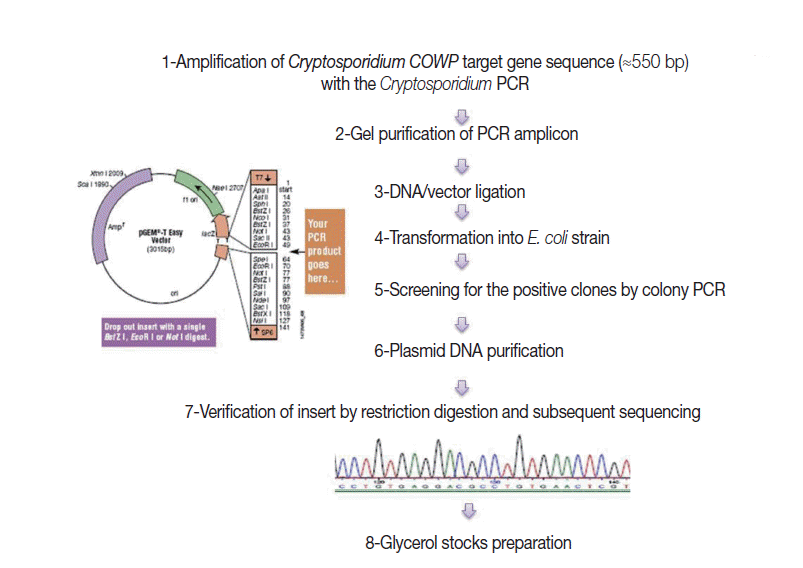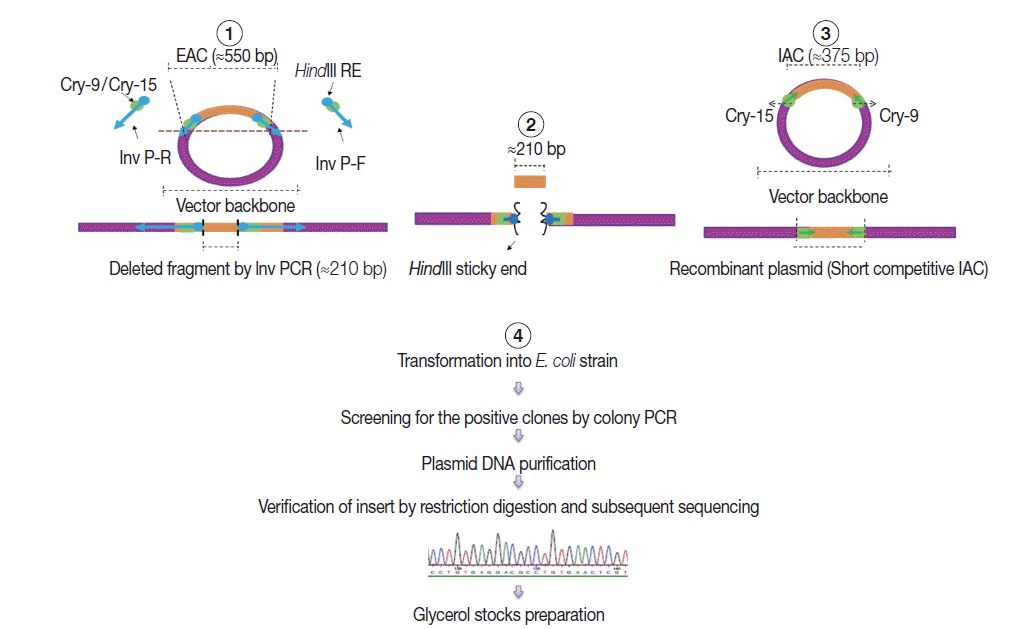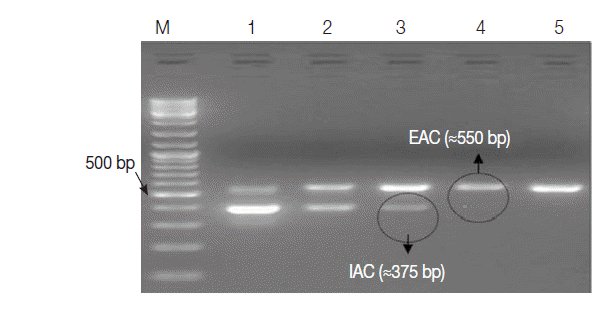1. Xiao L. Molecular epidemiology of cryptosporidiosis: an update. Exp Parasitol 2010;124:80-89.


2. Snel S, Baker MG, Kamalesh V, French N, Learmonth J. A tale of two parasites: the comparative epidemiology of cryptosporidiosis and giardiasis. Epidemiol Infect 2009;137:1641-1650.


3. Chalmers R, Katzer F. Looking for
Cryptosporidium: the application of advances in detection and diagnosis. Trends Parasitol 2013;29:237-251.


4. Schrader C, Schielke A, Ellerbroek L, Johne R. PCR inhibitors-occurrence, properties and removal. J Appl Microbiol 2012;113:1014-1026.


5. Oikarinen S, Tauriainen S, Viskari H, Simell O, Knip M, Virtanen S, Hyöty H. PCR inhibition in stool samples in relation to age of infants. J Clin Virol 2009;44:211-214.


6. Hedman H, Radstrom P. Overcoming inhibition in real-time diagnostic PCR. In Wilks M ed, PCR detection of microbial pathogens, Methods in Molecular Biology. 2nd ed. New York, NY. Springer Verlag Science and Business Media. 2013, pp 17-48.
7. Hoorfar J, Cook N, Malorny B, Wagner M, De Medici D, Abdulmawjood A, Fach P. Diagnostic PCR: making internal amplification control mandatory. J Appl Microbiol 2004;96:221-222.


8. Kobayashi A, Sano D, Taniuchi A, Ishii S, Okabe S. Use of a genetically-engineered
Escherichia coli strain as a sample process control for quantification of the host-specific bacterial genetic markers. Appl Microbiol Biotechnol 2013;97:9165-9173.


9. Yang R, Murphy C, Song Y, Ng-Hublin J, Estcourt A, Hijjawi N, Chalmers R, Hadfield S, Bath A, Gordon C, Ryan U. Specific and quantitative detection and identification of
Cryptosporidium hominis and
C. parvum in clinical and environmental samples. Exp Parasitol 2013;135:142-147.


10. Hadfield S, Robinson G, Elwin K, Chalmers R. Detection and differentiation of
Cryptosporidium spp. in human clinical samples by use of real-time PCR. J Clin Microbiol 2011;49:918-924.



11. Zaidah AR, Chan YY, Asma HS, Abdullah S, Nurhaslindawati AR, Saleh M. Detection of
Cryptosporidium parvum in HIV-infected patients in Malaysia using a molecular approach. Southeast Asian J Trop Med Public Health 2008;39:511-516.

12. Haque R, Roy S, Siddique A, Mondal U, Rahman SM, Mondal D, Houpt E, Petri WA Jr. Multiplex real-time PCR assay for detection of
Entamoeba histolytica,
Giardia intestinalis, and
Cryptosporidium spp. Am J Trop Med Hyg 2007;76:713-717.

13. Verweij J, Blangé R, Templeton K, Schinkel J, Brienen E, van Rooyen M, van Lieshout L, Polderman A. Simultaneous detection of
Entamoeba histolytica, Giardia lamblia, and
Cryptosporidium parvum in fecal samples by using multiplex real-time PCR. J Clin Microbiol 2004;42:1220-1223.



14. Abdulmawjood A, Roth S, Bülte M. Two methods for construction of internal amplification controls for the detection of
Escherichia coli O157 by polymerase chain reaction. Mol Cell Probes 2002;16:335-339.


16. Xiao L, Bern C, Limor J, Sulaiman I, Roberts J, Checkley W, Cabrera L, Gilman R, Lal A. Identification of 5 types of
Cryptosporidium parasites in children in Lima, Peru. J Infect Dis 2001;183:492-497.


17. Ochman H, Gerber AS, Hartl DL. Genetic applications of an inverse polymerase chain reaction. Genet 1988;120:621-623.


18. Woodman ME. Direct PCR of intact bacteria (colony PCR). In Coico R, Kowalik T, Quarles J, Stevenson B, Taylor R eds, Current Protocols in Microbiology. Hoboken, USA. John Wiley & Sons. 2005, pp A.3D.1-A.3D.6.
19. Spano F, Putignani L, McLauchlin J, Casemore DP, Crisanti A. PCR-RFLP analysis of the
Cryptosporidium oocyst wall protein (COWP) gene discriminates between
C. wrairi and
C. parvum, and between
C. parvum isolates of human and animal origin. FEMS Microbiol Lett 1997;150:209-217.


20. Green MR, Sambrook J. Molecular Cloning: a Laboratory Manual. 4th ed. Cold Spring Harbor, NY, USA. Cold Spring Harbor Laboratory Press. 2012.
21. Whelan JA, Russel NB, Whelan MA. A method for the absolute quantification of cDNA using real time PCR. J Immunol Meth 2003;278:261-269.

22. Lund M, Madsen M. Strategies for the inclusion of an internal amplification control in conventional and real time PCR detection of
Campylobacter spp. in chicken fecal samples. Mol Cell Probes 2006;20:92-99.


23. Oikonomou I, Halatsi K, Kyriacou A. Selective PCR: a novel internal amplification control strategy for enhanced sensitivity in
Salmonella diagnosis. Lett Appl Microbiol 2008;46:456-461.


25. Li F, Liu SL, Mullins JI. Site-directed mutagenesis using uracil-containing double-stranded DNA templates and
DpnI digestion. Biotechniques 1999;27:734-738.

26. Sachadyn P, Kur J. The construction and use of a PCR internal control. Mol Cell Probes 1998;12:259-262.


27. Bushen OY, Kohli A, Pinkerton RC, Dupnik K, Newman RD, Sears CL, Fayer R, Lima AA, Guerrant RL. Heavy cryptosporidial infections in children in northeast Brazil: comparison of
Cryptosporidium hominis and
Cryptosporidium parvum. Trans R Soc Trop Med Hyg 2007;101:378-384.


28. Hawash Y, Dorgham LS, Al-Hazmi AS, Al-Ghamdi MS. Prevalence of
Cryptosporidium-associated diarrhea in a high altitude-community of Saudi Arabia detected by conventional and molecular methods. Korean J Parasitol 2014;52:479-485.



30. Persson S, Olsen KE. Multiplex PCR for identification of
Campylobacter coli and
Campylobacter jejuni from pure cultures and directly on stool samples. J Med Microbiol 2005;54:1043-1047.







